
IN DEPTH
DOWNSIZING DOOM. Product quantity decreases while price increases. “Shrinkflation” is a phenomenon gaining criticism for lowering the cost of living, especially for low-income families
DORITOS: 5% decrease in weight





DOWNSIZING DOOM. Product quantity decreases while price increases. “Shrinkflation” is a phenomenon gaining criticism for lowering the cost of living, especially for low-income families
DORITOS: 5% decrease in weight



The Cookie Monster and President Joe Biden share a political stance, and it’s an opposition to “shrinkflation.” The term, which refers to the downsizing of product quantity, size, or weight without a decrease in cost, has gained recent traction as the president called out the practice in a Feb. 11 pre-Super Bowl video and the Mar. 7 State of the Union address.
“When buying snacks for the game, you might have noticed one thing: Sports drink bottles are smaller, a bag of chips has fewer chips, but they’re still charging you just as much,”
U.S. House of Representatives passes a bill supporting

Biden said in the video. “The American public is tired of being played for suckers,” he continued.
Shrinkflation has received increased attention due to social media, which allows consumers to broadcast their complaints and track the profits of their favorite companies. But despite the trendy name, downsizing prod ucts without downsizing price is nothing new. This practice dates back to feudal Europe, where it was considered ethical to shrink bread loaf size during a grain short age instead of raising prices. This way, sellers
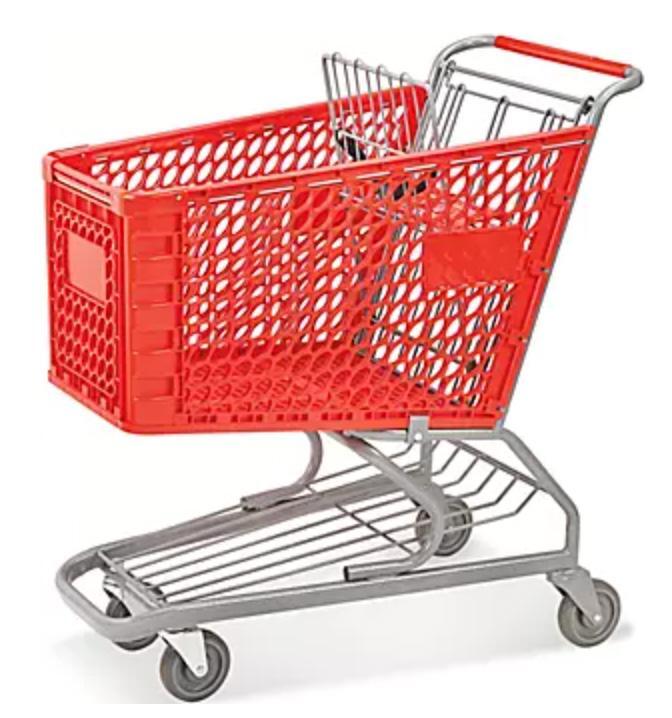
What’s your pet personality? From cockatiels to cats, students show photos and share stories about their furry family members.
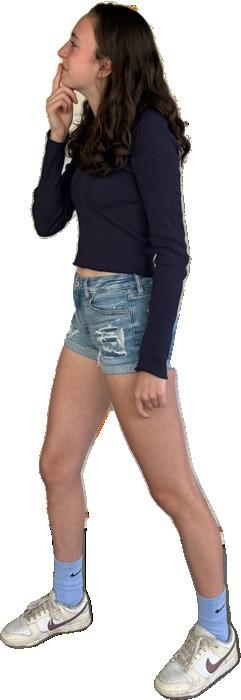
could maintain a “just price”- a term coined by Thomas Aquinas in the thirteenth century that refers to a fair transaction. In pre-revolutionary France, this justprice principle governed the economy. The community set basic food prices at an affordable value, often enforced by a threat of violence.
Story continued on pg. 8
Departing faculty and staff reflect on the legacy each leaves as they move on from the

GOODBYE GRADUATES.
Family, friends and faculty gather on the Front Lawn to witness the Class of 2024’s graduation. The school has upheld the tradition of Commencement since the school’s foundation. “[The awards celebrate] not just academics but how you show up in the community … your enthusiasm and school spirit,” Dean of Students Stacy Tepp said.
CHIEF VISUAL EDITORA series of traditions in May and June send graduating seniors onto their next chapter. One of the largest, Commencement, which will take place Jun. 9 at 4 p.m. on the Front Lawn (with a rain plan in the Huss Center for the Performing Arts) congratulates graduates who will leave the day equipped with diplomas.
The ceremony serves as a gathering event for family, friends and faculty to celebrate the graduates’ accomplishments. Some traditions, like the class speakers, have lasted for generations.
Others, like the commencement dress code, have changed to foster inclusivity. Previously, each student had been required to wear formal navy blue and white attire. Recently, the dress code’s colors have expanded to include cream and mint green.
“I think [Commencement attire] continues to be a conversation to make sure we’re inclusive of what people feel comfortable wearing … not restricting based on gender,” Dean of Students Stacy Tepp said.
Some changes, like wearing white dresses, were made to honor cultural diversity.
Senior awards are announced during the ceremony, including the Faculty Bowl, Alumni Bowl and Head of School bowls. Each has a separate significance, but they share the commonality of commending class members who have positively shaped the school community.
The awards celebrate “not just academics but how you show up in the community … your enthusiasm and school spirit,” Tepp said.
Besides taking the stage to accept a diploma with navy blue bi-fold with gold embossed lettering, seniors contribute to their celebration with
MY SISTER [SPOKE] IN 2014, SO I THOUGHT IT WOULD BE A FUN IDEA TO TRY FOR IT. “senior Humza Murad

a song performed by seniors from all the choirs and grade-level speakers. Selection process for speakers took longer than usual. All seniors can submit a speech video to the Senior Class Leadership Council in early April. Usually, the
council receives about two; this year, there were eight.
SCLC votes on speakers and the results are given to the administration for the final decision.
“I applied for two main reasons: one, I do enjoy speech writing; I think it’s a good skill to practice. Two, my sister gave it in 2014, so I thought it would be a fun idea to try for it,” senior Humza Murad said.
When selecting speakers, SCLC considers the target audience and guiding messages. “It’s good to have… a personal story... and looking into the future too,” SCLC advisor Aimeric Lajuzan said.
On the other hand, “You want to avoid... something specific,” he added, “[the audience needs] to understand what you’re talking about.”
Aside from the bowls, every student is given a white rose to walk in with at the ceremony. Some keep their rose, some bite the stem for pictures, but regardless, nobody leaves Commencement empty-handed.
Students leave with a flower, a diploma (maybe a rebellious cigar on the non-smoking campus) and the lifelong memory of walking across the front lawn.
PETER OSTREM
THE RUBICON mining in the Boundary Waters Canoe Area Wilderness.
On Apr. 30, the U.S. House of Representatives passed the Superior National Forest Restoration Act. Republican Minnesota Representative Pete Stauber presented the bill, re-instituting critical federal mineral leases and limiting regular environmental evaluation of plans within the Superior National Forest.
Sophomore Miles Atkinson, who spends time in the BWCAW said, “The first bill was a big step forward, so it’s disappointing to see them trying to take a step back.”
The bill aims to reverse the Biden administration’s ban on new
The House voted 212203 in favor of the bill, with a split along the party line. Generally, Republicans voted in favor of the bill while Democrats voted against it, apart from a few exceptions.
“From a legal perspective, I have no idea which side is right,” junior David Schumacher said. “I’m against the idea that the U.S. federal government can make a decision that will affect water outside of their legal domain.”
Although the House of Representatives passed the bill, it is unlikely to become law. It would have to pass through the
FROM A LEGAL PERSPECTIVE, I HAVE NO IDEA WHICH SIDE IS RIGHT. “junior David Schumacher

Democratic-controlled Senate to become a law in addition to President Joe Biden’s signature, who has already spoken against it.
Stauber argues that the original Biden bill constricts the area’s industrial potential, which he aims to maximize.
Corrections are printed at the bottom of News p. 2. Corrections will be published in the month following the error and, if the story is also published online, will update following the online corrections policy.
The Democratic party largely views Stauber’s position as disregarding the bill’s environmental consequences.
“This would overturn all the public input, the overwhelming public input, in protecting this unique watershed,” Representative Betty McCollum (MN-D) said of the bill on her official website.
Atkinson is “...happy that [the bill] won’t become official, most likely.”
Sophomore Nellie Larson agrees: “I hope that the bill doesn’t get passed. I think the original bill was a good thing, so hopefully they don’t ruin that.”

Although most people don’t favor of a reversal of the BWCAW mining ban, many of the bill’s perpetrators argue the importance of mining and this
bill’s implications on the mining industry. The BWCAW encompasses over 225,00 lakes, rivers, and forests in northern Minnesota.
NEWS - Family Discovery Night was inconsistently defined as “Discover Night.”
SAC
Co-Presidents: Aarushi
Bahadur & Natalie Waibel
VP: Nijah Johnson
Treasurer: Florence Barrera
Representatives: (‘25) Raven Glaser, Mason Hang, Liam Sullivan, Sydney Zimmerman; (‘26) Raina Heidkamp, Zoe Huelster, Nellie Larson, Lilly Spurgeon; (‘27) Caden Deardurff, Tallulah Dogwill, William Drake
STC
Co-Presidents: Lorenzo Good & James Welsh
Co-Secretaries: Milan Mishra & Mattias
Halloran
Representatives: Finn Cairns, Annika Kim, Sam Hilton
USC
Co-Presidents: Cerena Karmaliani & Annie
Zhang
Co-VPs: Thomas Chen & Carys Hsiung
Secretary: Nabeeha Qadri
Treasurer: Isaak
Senaratna
Representatives: (‘25)
Bora Mandic, Nicholas
McCarthy, David Schumacher; (‘26)
Zain Kizilbash, Zimo Xie, Shefali Meagher, Evan Morris; (‘27) Zack Berchenko, Zahir Hassan, Adi Narayan
Posters, posts and petitions. As the school year winds down, the election season ramps up.
Although campaigns have been finalized and positions have been elected, many in the Upper School community still ask the same question: What is USC, STC and SAC and what do they represent?
The Upper School Council, meets during the Elected/Selected X-Period slot. In meetings, they discuss current proposals, brainstorm new ones, and plan schoolwide events such as Community Day or House Cup events.
Different roles in committees hold varying responsibilities. Treasurer, for example, aids in the provision of funds for clubs and affinity groups. All members are responsible for implementing change prioritized by the student body.
“The primary mission of USC is to be that representative position between the student body and administration,” said newly-elected USC co-president Cerena Karmaliani. “Through USC, there’s a concrete set of steps to work to further
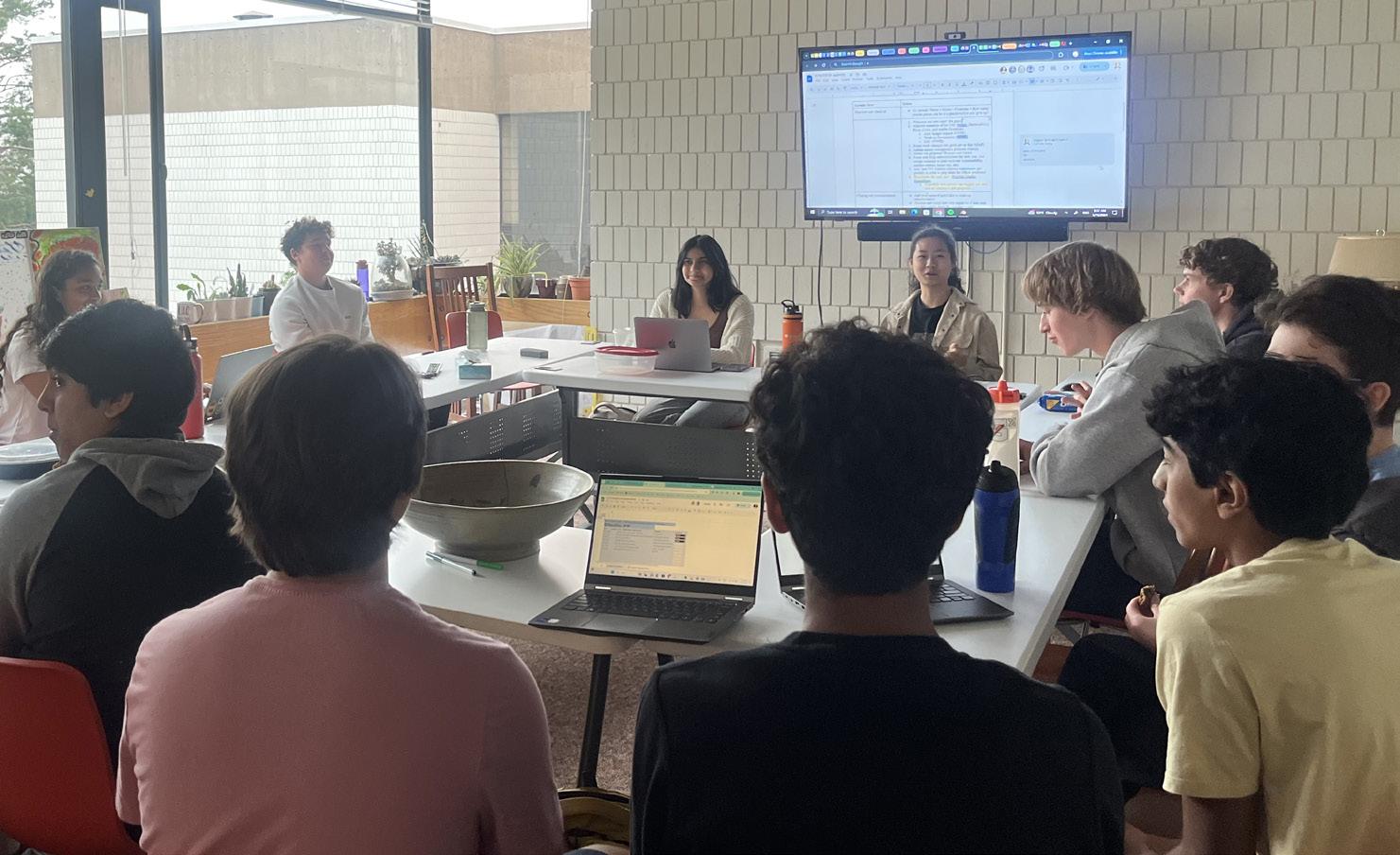
whatever you want.”
The Student Technology Committee still works closely with its former parent group, USC. The council is the smallest of the three with only one representative per grade plus the officer positions. They serve as the liaison between the technology department and the student body. In the coming year, the group hopes to update the student newsletter and develop academic use of AI policies.
The largest group is the Student Activities Committee with four representatives per grade, plus treasurer, vice presi-
THE PRIMARY MISSION OF USC IS TO BE THAT REPRESENTATIVE POSITION. “junior Cerena Karmaliani

dent, and president. SAC collaborates with the administration and USC to plan school events and activities. Rising sophomore William Drake was recently elected as an
SAC representative. “I’m excited to get to make an impact around the school and hopefully make the school a more positive environment,” he said.
The groups had their first meeting on May 6. Newly elected officers adjusted to their roles. Class representatives from the past year attended but by the May 20 meeting had been replaced by the newest representatives.
The initial meetings were lighthearted. Officers explained their initiatives while representatives began work on campaign promises. USC class representatives
Adi Narayan and David Schumacher, for example, have already started working on a proposal to replace Meatless Wednesdays with other sustainable practices. “I’m proud of the progress we’ve made in such little time,” Narayan said.
These groups, however, aren’t complete just yet — elections for rising 9th-grade representatives will occur next September. Selected groups, class leadership councils and the new honor council, are yet to be announced.




a University of Minnesota student, said, “the discussions around [the protests] were a lot harder to avoid.”
The right to protest, historically, is an essential component of democracy. Campus protests on the Israel-Hamas war have occurred nationwide, and as a result, over 2000 students have been arrested. At Columbia University in New York, commencement was canceled and the school transitioned into hybrid learning.
Columbia University offers a clear portrait
IT CONCERNS ME THAT UNIVERSITY OFFICIALS SEEM TO THINK THAT PROTESTS SHOULD NOT OCCUR. “
history teacher Andrea Moerer

of what the protest arc looked like this spring. Around Apr. 20, students set up an encampment
on the east lawn entrance of campus, named the “Gaza Solidarity Encampment Community.” It filled with hundreds of students by the end of the week. University President Minouche Shafik approved the first police involvement after protesters ignored her warnings to disband their encampment.
Encampments across the nation popped up on campuses across the nation, and after the refusal to cooperate, a number
of student protesters were arrested and suspended.
The Columbia University protest escalated to illegal action after entry into Hamilton Hall Apr. 30, and a second police raid was issued. US history teacher Andrea Moerer believes protesters should be responsible for their actions.
“There may be consequences and that is part of protesting — those who break the rules should expect repercussions,” she said. “It concerns me that university officials seem to think that protests should not occur or are surprised when they do.”
Columbia University was also a campus with pro-Israel protests. The week of Apr. 15, hundreds of pro-Israel protesters stood together in front of the main lawn, waving the flag of Israel and demanding the rescue of hostages in Gaza.
At the University of Minnesota on the morning of Apr. 23, eight students and one staff member were arrested at a
Pro-Palestinian encampment on school grounds.
Sam Konstan (SPA ‘21), a U of M student, was not especially affected by the protests. “It’d be hard not to notice [the protests],” he said. “How much it affects somebody’s day-to-day life is a combination of a choice and their schedule.”
The protests never significantly impacted Konstan’s ability as a student but “the discussions around [the pro -
tests] were a lot harder to avoid.”
A second encampment was set up at the U of M on Apr. 29 on Northrop Lawn, despite the police dismantlement of the encampment a week earlier. It included hundreds of students and faculty in support of the people of Gaza. The organizers voluntarily took down the encampment after administrators agreed to transparency demands.
Apr. 23:
Nine Pro-Palestinian protesters were arrested by the U of M police at an encampment.
Apr. 30:
University of M students set up another tent encampment, calling for the school to divest from Israel.
OUR MISSION
We strive to capture the spirit of the community through its stories while inspiring deeper conversations. Above all, we stand for integrity in our pursuit to inform and engage our readers.
St. Paul Academy and Summit School 1712 Randolph Ave • St. Paul, MN 55105 rubicon.spa@gmail.com www.rubiconline.com @TheRubiconSPA
MAY 24 STAFF
RUBICON
EDITOR-IN-CHIEF
MANAGING EDITOR
CHIEF VISUAL EDITOR
OPINIONS EDITOR GOOD QUESTION EDITOR IN DEPTH EDITOR
FEATURE EDITORS
SPORTS EDITOR A&E EDITOR
MIXED MEDIA EDITOR
PHOTOJOURNALIST/ SOCIAL MEDIA
PHOTOJOURNALIST ILLUSTRATOR
DIRECTOR OF RUBICONLINE
PRODUCTION MANAGER
BEATS MANAGER NEWS EDITORS
OPINIONS EDITOR
FEATURE EDITORS
A&E EDITORS
SPORTS EDITORS
CREATIVE DESIGN MANAGER
RUBICON TV EDITOR
SOCIAL MEDIA MANAGER
PHOTOJOURNALISTS
Annie Zhang
Juan Miguel Adams
Georgia Ross
Johanna Pierach
Gavin Leuthold
Sonia Kharbanda
Olympia Wolff
Amanda Hsu
Lina Abid
Mattias Halloran
Sam Galarneault
Peter Ostrem
Annika Kim
Audrey Peltier
Erik Bjorgvinsson
Ivy Evans
RUBICONLINE
Aarushi Bahadur
Greyson Sale
Thomas Chen
Peter Lipinsky
Audrey Jansen
Lani Ngonethong
Lucy Thomas
Nabeeha Qadri
Andrew Lipinsky
Yassin Mokbel
Tamari Christopher
Elizabeth Tuttle
Zimo Xie
Nora McKoy
Mariam Malik
Thomas Kovarik
Murphy Miltner
CONTRIBUTORS
Carys Hsiung, Soren Johnson
OUR CLASS OF 2024 GRADS
SPORTS EDITOR
OPINIONS EDITOR
SERVICE JOURN. EDITOR
THE RUBICON EIC
THE RUBICON EIC
CREATIVE DESIGN MANAGER
DIRECTOR OF RUBICONLINE
PRODUCTION MANAGER
FEATURE EDITOR
OPINIONS EDITOR
SPECIAL PROJECTS

VALUES REIMAGINED. The school’s six core values are: achievement, accountability, community, resilience, inventiveness, and passion. These can remain important guiding principles for current students and alumni/ae of the school; they take on new meaning but are still applicable for graduates’ next journeys.
Packing up the school’s greatest gifts doesn’t require a backpack
EDITORIAL THE RUBICON STAFF
The Class of 2024 is out of the building on senior project, looking toward Commencement, and many will be rightfully focused on the adventures ahead.
These milestones offer a chance to reflect on what each student takes with them: values developed during the time here. The mission “Shaping the minds and hearts of people who will change the world” is about a future beyond school. Every student develops their own personal values, but the values prioritized by the school offer a foundation that guides graduates, and all students, as they turn from a student into an alum.
These six values are published alongside the mission statement on the SPA website.
Clara Ann Bagnoli
Eliza Farley
McKinley Garner
Claire Kim
Orion Kim
Rita Li
Clara McKoy
Eliana Mann
Zadie Martin
Siri Pattison
Davan Rosen
ADVISER
Kathryn Campbell, CJE
PUBLICATIONS ASSISTANT Meghan Joyce THE RUBICON
there when you need it for a return to campus, a networking connection, or a reunion. You may become the support for someone else; be ready to lend a hand.
RESILIENCE: Many have heard the cliche phrase, “Moving past failure.” Resilience means taking life lessons from failure, pain, and hardship to bounce back stronger. Part of the learning in school happens in moments of struggle, when students lean on faculty, family, and peers to get through. In life, this teaches us how to build connection for good times and bad. In addition to finding perseverance within yourself, seek out networks of support, much like the wide variety of relationships cultivated at school, and trust them to help.
THE VALUES PRIORITIZED BY THE SCHOOL WILL BE A FOUNDATION THAT GUIDES GRADUATES.
ACHIEVEMENT: While achievement within the academic framework neatly falls on an A-F scale, achievement after graduation looks different. Setting personal goals to push yourself to improve is essential to success in all aspects of life. From developing individual skills to building a career, striving to achieve something is critical. Your goals and aspirations will look different than your peers because achievement in life means something different for everyone.
ACCOUNTABILITY: The school provides a wide variety of opportunities for achievement, learning and academic excellence with many measures of accountability. Alums will, however, be accountable for their words and actions, which will mean facing criticism or consequences. Acknowledge the power you have in choices that impact not only yourself but others. Be curious and kind with your words, thoughtful and intentional in action, and create space for others to do the same.
COMMUNITY: Many families are drawn to the small size and tight-knit culture at the school. Still, this community includes a broader network of former students, and there are opportunities for alums to stay involved. During their time at school, alums served as both participants in their communities and as facilitators, making it possible for others to feel welcome; remember this dual role in the communities you join. Some connections will be stronger than others and change over time, but the school community will be
INVENTIVENESS: Every graduate will embark on their own new and authentic path. However, contrary to the concept of inventions, nothing is truly original. All ideas are inspired by the people and world around us. While the school’s values emphasize courage and curiosity to see the world in new ways as key to invention, so are collaboration and peer appreciation. Your life will need to be designed, planned, and built through your own ingenuity. Recognize the strength that exists in valuing those accomplishments built on what’s come before, on those who inspire, and on forging (or abandoning) a path.
PASSION: When it comes to success, passion is often an afterthought. We are sometimes discouraged from following our passions because they may not lead to conventional definitions of success. Pursuing one’s passion does not have to come at the expense of something else. Expand your mind to label passion as a flexible, essential part of life. Recognize that being multifaceted and exploring love is its own form of success, as it allows you to grow as an individual. Dissolve the term of its rigidity, and find meaningful ways to bring a sense of fulfillment in life. Even if you are not fully enthralled with everything you do, recognize the potential for passion in other areas, and seek out the next thing that lights up your heart.
Graduates are close to moving on from the role of student to joining a network of thousands of alums. “Changing the world” doesn’t rely on singular achievements or future awards. It happens when our community honors the values that have equipped us.
The year starts one day early as all-grade retreat day moves to the day before school, and while students lose a day of summer...
SPA THINKS
What did you get out of ‘23-24 all-grade retreats?
 SAM GALARNEAULT THE RUBICON
SAM GALARNEAULT THE RUBICON
Meeting our advisory ... to be able to build a better connection with those important people.
freshman Eliana Moser “
Being able to do stuff with my friends ... and being able to talk to people [I] wouldn’t normally talk to.
sophomore Sam Ray “


All-grade retreats are a special opportunity for new and returning students alike to build relationships with teachers and peers. Retreats can be many things; some find them fun and exciting, others dread them, and they can also be a source of apprehension. Nevertheless, student participation and engagement in these retreats can affect and improve the experience.
munity, have fun, make stronger connections with new and old students and faculty, and learn more about each grade’s environment. Moving the all-school retreats to before classes start is an opportunity to strengthen the community and establish a healthy school culture before the school year begins.
goal is to discover one’s identity, the sophomore retreat aims to learn more about their role as a member of a community, the junior retreat digs deeper into leadership and serving as a role model, and the purpose of the senior retreat is to focus on legacy and leadership.
gives it a distinct purpose. Tepp strongly encourages students to use these retreats to their fullest extent: “These retreats are whatever you make of it.”
I wish we had more free time during the retreat and less scheduled activities.
junior Adele Gjerde “
Next year, students will attend a mandatory grade-level retreat before the school year begins. SPA prioritizes taking every grade on retreats but each typically occurs at a different time throughout the year (for example, this year, the sophomore retreat was moved to January).
The goals for these retreats are to build com-
Many different faculty members collaborate on planning retreats, including the deans and grade-level advisors. There is always a lot of thought put into planning and executing these retreats. In doing so, the faculty and administration encourage feedback from students to determine areas of improvement for future retreats.
Each grade-level retreat is designed to serve an intended structure.
According to US Dean of Students Stacy Tepp, the freshman retreat’s
[RETREATS] WILL ONLY WORK ALONGSIDE THOSE WHO ALLOW THEM TO SERVE THEIR PURPOSE.
freshman Sam Galarneault

When students understand the goal for each retreat, they can strive to achieve it and make the most of it. This makes the retreat meaningful and
Tepp’s words greatly express the meaning of these retreats. Retreats offer a fun opportunity for participants to get more in-depth with the community. They will only work alongside those who allow it to serve its purpose.
The more students who participate in these retreats with an open mind to this opportunity, the more effective it will be for them to achieve the goals that these retreats aim to accomplish. The change to hold the retreats before the beginning of the school year is a chance to start the year off right, with a focus on improved community relationships and a respectful and inclusive school culture.
GAVIN LEUTHOLD THE RUBICON
Tents filling university quads. Large flags and colorful banners waving in the air.
Images of campus protests have sparked debate over whether these are depictions of free speech or hate speech, and what constitutes a peaceful protest. While their message may be controversial, students’ right to protest holds value.
In the U.S., freedom of speech is a core principle, protected under the First Amendment. Protesting is just one of the many ways Americans can convey their beliefs. It is important that students protesting at universities are still included in the protection of freedom of speech that this country upholds.
Protests combat the normalization of a conflict. As a war stretches on, it fades in urgency in the public discourse. There are so many global conflicts that many will quickly forget about one and move on to the next.
Protesting at universities challenges this ignorance and shines a light on previously overlooked issues. Furthermore, college campuses have long been a place for student expression.
PROTESTS COMBAT THE NORMALIZATION OF A CONFLICT.
freshman Gavin Leuthold

In the 1960s, the Civil Rights Movement at colleges pushed against segregation and advocated for human rights. During the Vietnam War, student protests helped bring anti-war objectives to light among the public. This movement contributed to the U.S. signing the Paris Peace Accords in 1973, ending the war.
More recently, the #MeToo movement on college campuses and beyond, which began in 2006 and grew in
popularity in 2017, has changed the conversation around sexual harassment and pushed universities to institute stricter policies.
The ongoing protests surrounding the Israel-Hamas war are not unique in their expression on college campuses; as such, protestors’ rights should be upheld as were the rights of students participating in earlier movements.
Students’ right to protest cannot be taken away even when it disrupts events such as graduation. Since the protests push administrators to take certain actions, it is essential that people are able to protest their opinions regardless of the side of the conflict they align with until they reach agreements or compromises with those in power.
It is important to continue respectful discussions about how communities, particularly universities, can balance free speech with events and peoples’ desire to
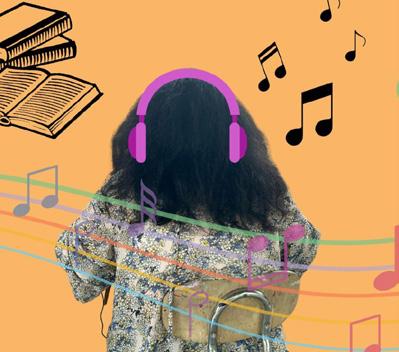

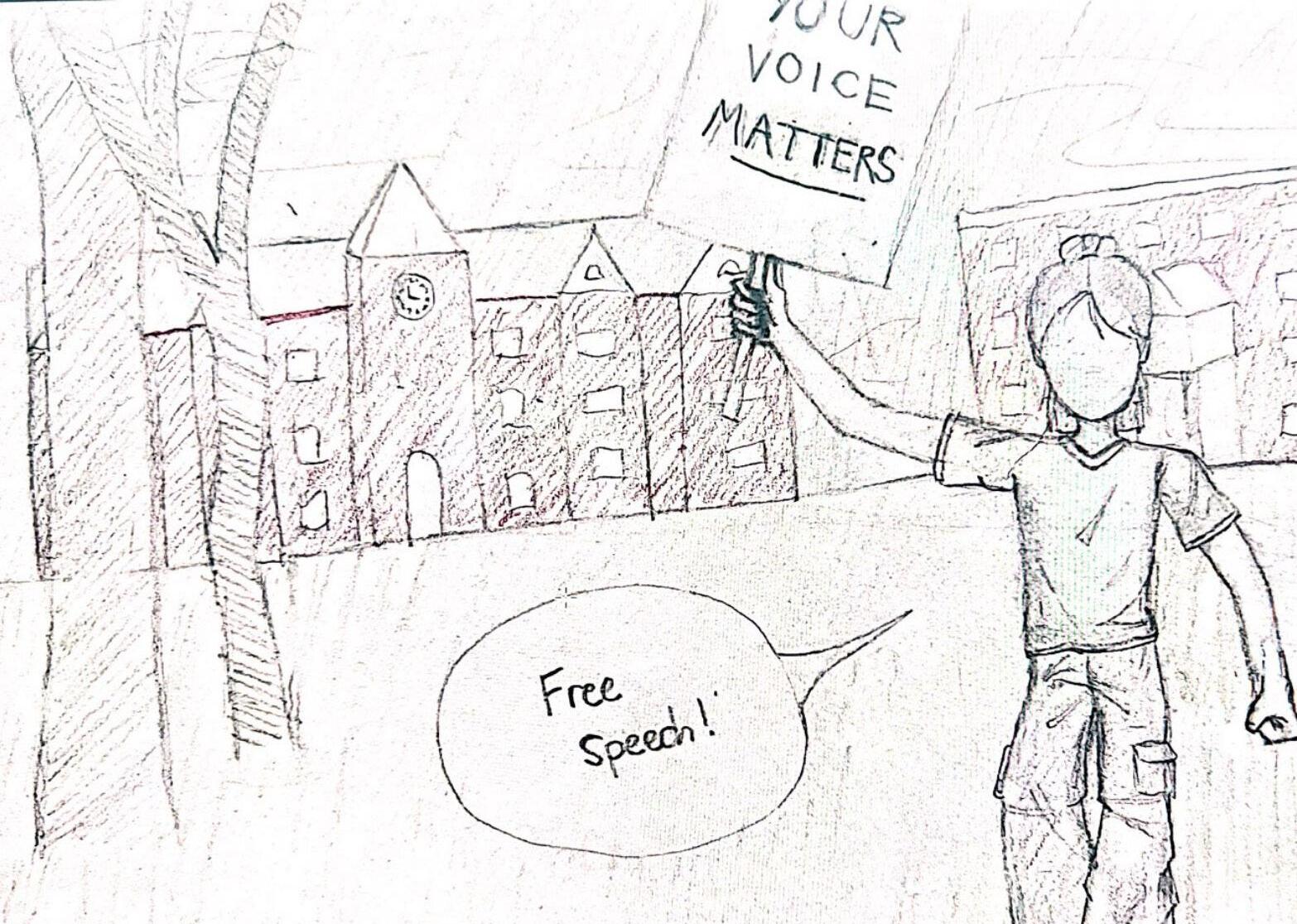
CONFLICT ON CAMPUS. Images of student protests on college campuses have filled the news recently, though student demonstrations at universities are nothing new. Free speech, including the right to protest, is one of the core values of American democracy and must be upheld on its college campuses.
continue with their daily lives.
The main counterargument is that the ongoing protests are invoking hate speech and violence. It is important to only tolerate protesting at universities if the support for a certain cause or sympathy for a particular side does not include
calls for violence towards another group of people.
Hate speech at protests distracts from the overall message urging change, and therefore takes away from the movement.
Student protests are protected under the First Amendment, bring light to global problems, and push administrators to
take action. Tolerate campus protests. Reject hate speech. Allow peaceful protests to occur at universities because free speech must be valued and supported.
READ MORE ABOUT ONGOING PROTESTS ON COLLEGE CAMPUSES IN NEWS, P. 3.


The upper school hosted the annual academic award ceremony May 23, in which awards are given to students who have shown exceeding interest, engagement, or mastery of a course. Seniors awards and Heads bowls are given at Commencement.
An educationally and culturally diverse community has no space for blackand-white academic awards. Towards the end of the year, academic awards and achievements take center stage, distracting students from the primary focus of their academic journey — the learning along the way. Instead of fostering a love for a specific field of study, awards create an unhealthy obsession with achieving recognition. Students, driven by accolades, may resort to memorization and rote learning rather than embracing critical thinking and creativity. Consequently, pursuing awards becomes a race for superficial success rather than continuous exploration

WHY AWARD STRESS. The pressure to achieve top marks and outperform peers can lead to stress, anxiety and detracts from the joy of learning. By perpetuating a culture where academic awards are the pinnacle of success, schools compromise students’ mental health.
The emphasis on academic awards can highlight existing inequalities within educational systems. Traditionally, students from higher socioeconomic backgrounds enjoy more access to resources and opportunities than their less privileged peers. For example, students from low-income backgrounds may have to work after school or on weekends and consequently have less time to focus on school work. Educational institutions may inadvertently marginalize these students by placing undue importance on academic awards, widening the gap between the haves and the have-nots.
The intense focus on academic awards can negatively impact students’ mental health. The pressure to achieve top marks and outperform peers can lead to heightened stress, anxiety, and burnout. This unhealthy environment detracts from the joy of learning and the development of a well-rounded student. The Robert Wood Johnson Foundation (RWJF) works to promote health equity and came to a similar conclusion in its 2018 report on adolescent wellness, naming the “excessive pressure to excel” as one of the primary factors impacting children today. By perpetuating a culture where academic awards are the pinnacle of success, schools may compromise students’ mental and emotional health, ultimately undermining their long-term educational and personal development.
The one-size-fits-all approach of academic awards does not acknowledge the diverse ways in which students learn and excel. By prioritizing academic achievements, schools overlook the diverse talents and contributions that enrich our educational communities. Educators, administrators, and policymakers must collaborate to create inclusive environments that celebrate every student’s unique strengths and contributions. By doing so, schools can nurture a community where learning is a joyful and equitable journey for all.
PUBLICATION INFO The Rubicon is published eight times a year. We distribute 450 copies of each issue to the Upper School which are available for free.
ADVERTISING The Rubicon does not accept advertisements.
ANONYMOUS SOURCES Although it is always preferable to use names when reporting, there are times when it is necessary to protect those we report on. In the case of a student, the use of grade level as a name designation will be the preferred method of anonymity.
BY LINES credit the individual who conducted interviews, drafted, revised and fact-checked an assigned story. Shared bylines are given to joint effort
assignments. Stories that include supplemental materials include a credit at the bottom that states “Additional reporting by” followed by the name of the reporter.
EDITORIALS articulate the collective opinion of The Rubicon staff, while mini-editorials, opinions pieces, arts reviews, and columns belong to the author.
SUBMISSION GUIDELINES
Opinions are welcomed as Letters to the Editor or Submitted Opinions and may be published in the print or edition. Letters to the Editor should not exceed 400 words and Submitted Opinions should not exceed 650 words. Both may be edited for length and style. All pieces must be submitted and
The student body is naturally competitive, whether or not students consciously contribute to this culture. With high expectations all around, any student could feel that their accomplishments are overshadowed or meaningless.
While it may seem that completely eliminating award ceremonies would reduce this potentially toxic environment, that would not be a productive way forward in our community. Academic awards create a chance for individual students to be distinguished for their hard work. Awards span across all classes and recognize stu dents for a variety of skills, including mastery of a subject and engagement with the course. This offers opportunities for students with varying interests and talents to be celebrated.
It is validating and reassuring for high school students to have their teachers voice their appre ciation of their work and to be honored in front of their peers. It encourages stu dents to contin ue to put in their full effort and for that effort to per sist throughout the year and all of high school.

AWARD EFFORT. Awards encourage students to continue to put in effort. It is validating and reassuring for highschool students to have their teachers and peers appreciate their work.
When students feel that their hard work isn’t valued, the school year can feel never-ending, and students’ quality of work may suffer. A 2021 study published in the Journal of Competency-Based Education found that student recognition through awards increased feelings of persistence and success, and students who were previously struggling with their school work showed the highest increase in persistence of all students who were honored. Furthermore, the study reported that 15.6% of surveyed students were planning on quitting school and changed their minds after receiving the award.
Beyond academics, decades of perspective cannot be wrong; time and again, researchers have asserted that it can be beneficial for students to hear faculty recognize their unique strengths. In his 1931 journal article, Herbert A. Clugston, a professor whose research centered on ethics and systems in education, details the importance of individual recognition, specifically in high school. He writes, “Adolescence marks the beginning of the individual and a growing consciousness of self.”
An award doesn’t make a student who they are, but it represents a strength that is recognized and admired by their community.
The purpose of award ceremonies is to celebrate individuals, so it’s important to remember that each individual is different, and should be celebrated accordingly. Shift from the mindset of rejecting all awards, acknowledge that each award winner is an individual with their own areas in which they excel, and celebrate that students have the chance to be recognized for their hard work.
will be published with a full name.
UPDATES AND CORRECTIONS
During the post-critique process, staff members identify inaccuracies and report feedback from readers. The staff publishes corrections when an error is discovered during critique or reported to a staff member. Corrections should be directed to the Editor in Chief or appropriate section editor.
IN PRINT: Corrections are printed at the bottom of News p. 2. Corrections will be printed in the month following the error and, if the story is also published online, will be corrected following the online corrections policy.
PHOTO CREDITS Photos taken by staff members are labeled with their
respective staff. Images sourced from outside of the publications staff are credited information pertaining to their origination.
NAME AND PRONOUN USE
The Rubicon uses the name and pronouns reported by the individual source. Each interview and survey begins with a request to say and spell the person’s name and to share the pronouns they would like to see published in the story, and the reporter is transparent about where the story will be published. If a mistake is made in the course of reporting, a correction will be posted per the corrections policy.
CONFLICTS OF INTEREST The Rubicon news and Ibid yearbook avoid
conflicts of interest while also honoring the fact that our reporters are involved in the school and local community beyond their work on staff. Staff members avoid writing about students, teachers, student clubs, affinity groups, and organizations that they are closely involved with. The reporter is always responsible for disclosing conflicts of interest, and if a conflict of interest comes to light after publication, it does not warrant removal of the story. If it is in the best interest of a source to be interviewed by a close friend in the case of a sensitive topic, the interviewer will not write the story— they will solely conduct the interview. Unavoidable conflicts of interest are specifically mentioned at the top of the story. Photographing news events is never a conflict of interest.
Is the theory that you look like and act like your pet true?

No I don’t think I look like my cats because they have gray and black hair and are a lot smaller than me.
junior Sam Peterson


No I don’t think I look like my dog but my mom does, they both have black curly hair … and their eyes are the same.
sophomore Dia Chaney “


No I don’t think I look like my pet because my two horses are very old and kind of stupid.
freshman Elliot Pierach “


My dog is similar to me because we have the same personality, we’re both energetic.
sophomore Luwam Mebrahtu


 SONIA KHARBANDA THE RUBICON
SONIA KHARBANDA THE RUBICON
Anyone who’s ever watched a dog show, such as the Westminster Kennel Club Dog Show that took place this May, knows that people will go to surprising lengths for their pets. Some delight in dressing their pets up for Halloween, while others sign their pet’s name on their annual holiday card; the question of cats versus dogs can be seen as an indicator of personality.
For many pet owners, their pet provides a constant companion. Sophomore Franny Wagner’s family has two chickens and two cats. She has an especially close bond with her cats: “I look forward to coming home every day and having my cats [there],” she said.
Similarly, junior Max

Some studies have reported that a close relationship with a pet can improve the owner’s mental health. The Centers for Disease Control and Prevention (CDC) noted in a fact sheet that owning pets can lessen anxiety and loneliness while providing outlets for exercise and socialization. Freshman Florence Barrera has noticed her pets’ impact on her mental health, “My dog especially really emotionally supports me especially when I’m having a hard time with school or friends … he’s always there,” she said.
Junior Helen Townley has several pets: a dog, Fergus, a cockatiel, Snow Coco, and a bearded dragon, Crickets. While her dog spends the most time with her mom and her bird is more of her sister’s pet, her pets still play a role in her mental health: “When I’m feeling down I’ll go hang out with my bird and my dog,” she said. “Definitely, I think [pets] can help with mental health.”
owning a pet provides unique physical health benefits. The CDC also reported that owning a pet can lead to lower blood pressure and cholesterol levels. Furthermore, a systematic review of studies around dog ownership and mortality, published in October 2019 in the American Heart Association’s journal “Circulation,” found dog owners 24% less likely to die of any cause than non-dog owners. While these benefits are positive, most people probably don’t adopt or purchase a pet with their physical health in mind.
“I
think the
theory is true because my dog and I
have a similar
personality ... he’s either really tired or really hyper.
freshman Isla Collins “

SUBMITTED PHOTO: Franny Wagner FRANNY’S FAMILY CONVINCED. To persuade her family into owning chickens, sophomore Franny Wagner created a PowerPoint presentation. However, the chickens weren’t her first pets. She also has two cats.
Johnson has two sheepadoodles, Millie and Milo. He loves his dogs most for the friendship and fun they bring to his life. “I like my pets a lot because they’re always there to cheer me up,” he said.

SUBMITTED PHOTO: Helen Townley
HELEN’S COCKATIEL & CO. Junior Helen Townley owns a cockatiel, a dog, and a bearded dragon. Although she doesn’t bear the majority of the responsibility to care for them, she finds that they improve her mental health.
Aside from mental and social well-being, other studies have shown that
A common reason why families will adopt or purchase pets is for the commitment and sense of responsibility they provide. Wagner knows this responsibility well; acquiring her chickens involved persuasion, and taking care of them requires dedication. “I made a PowerPoint presentation in order to convince my family,” Wagner said. Now, she handles all of their care, and “it’s been hard some days because, in the winter, their water freezes over so [I] have to replace it last winter like twice a day,” she said.
Meanwhile, Barrera has two dogs, a cat, and a horse, and their family shares the work, “Whoever feeds them, feeds them, and whoever walks them, walks them … usually, I will walk one of the dogs either in the morning or in the afternoon,” Barrera said.
Whether a pet offers companionship, life skills, opportunities to exercise and socialize, or health benefits, many SPA students find their pets special.



EVOLUTION OF SHRINKFLATION
continued from pg. 1
The community set basic food prices at an affordable value, often enforced by a threat of violence. When the prices of supplies fluctuated, shrinkflation ensured that bakers could still make a living. However, they sometimes resorted to irregular additives such as cobwebs to keep their loaves an acceptable size. So, while downsizing products without decreasing price is not a novel practice, the public once more widely accepted it.
“I think shrinkflation could be ethical, but I feel like instead of increasing


prices, it should just be less in bulk but the same price per unit,” freshman Rachel Guo said. Sophomore Hazel McCarthy is likewise in favor of this Europe-adjacent model. “People complain if the prices go up, but then they also complain that the food goes down. So I would prefer food goes down, [and] price stays the same,” McCarthy said. Fast-forward to the late twentieth century, a 1988 report indicated that the coffee brand Chock Full o’Nuts had reduced their one-pound coffee can to 13 ounces. By 2003, the cans were 11 ounces. Additionally, beginning around 2008, ice cream brands started selling their ice cream in





48-ounce containers, as opposed to the earlier 64 ounces, according to the Federal Reserve Bank of St. Louis.
PEOPLE COMPLAIN IF THE PRICES GO UP, BUT THEN THEY ALSO COMPLAIN THAT THE FOOD GOES DOWN. “sophomore Hazel McCarthy

“I wrote one of the first articles on looking at how consumers respond to shrinkflation, but before my article,
there were a couple… not sort of rigorous economic analysis, but documenting that inflation has been happening And those studies were from the 1970s, 1980s,” Metin Çakir, a professor in the Department of Applied Economics at the University of Minnesota, said. “So [shrinkflation] does have quite a bit of history… it’s a practice that’s been used for decades for sure.”
The current outrage is evident at a federal level, as Biden has called for a bill allowing the Federal Trade Commission to enact regulations to curb shrinkflation.
Although the opposition to shrinkflation has loudly and publicly in-
creased, government data collectors found fewer instances of it in 2023 than in 2016.
When calculating inflation numbers, the Federal Reserve Bank of St. Louis “treats shrinkflation as a price increase.”
This ensures that one can accurately compare prices despite a change in size, although the responsibility of detecting a decrease can often fall on the consumer. In 1967, the Fair Packaging and Labeling Act (FPLA) was enacted to assist consumers in making informed choices. The Act requires each household “consumer commodity” under its coverage to include a label that states the net quality of contents in
good habit to check the weight or volume of the item compared to the price before purchasing.
terms of weight, measure, or numerical count.
Shrinkflation is on a downward trend, with the New York Times reporting that government officials caught fewer downsized products in 2023 than in previous years. However, with specific items such as paper towels up 3.6 inflation points from 2019 to 2023, big prices continue to accompany little packages.
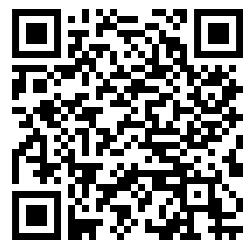
According to a survey conducted in 2022, over half of the respondents noticed a downsize in the product size of snacks, with an even larger percentage being concerned about the phenomenon. While the survey sees that people notice this most frequently in food items, this phenomenon, otherwise known as shrinkflation, has been rampant in commercial products due to companies looking for ways to save money. However, there are a few ways an average shopper can avoid paying more for less.
A simple way to combat shrinkflation is to check over the product on the next shopping trip. Before purchasing an item, turning the package around and checking the product’s prices and size will reveal the option that will give the most quantity over cost. Another way to see if a brand may be utilizing shrinkflation strategies is to check if the packaging has changed, which may indicate an updated product has been altered, becoming smaller.
brands or brands from retailers that are often cheaper and more resistant to changing the packaging and size of items. More advice includes keeping track of unit pricing by dividing the item’s cost by the product’s quantity or weight to make it easier to see which items are marked up for more money with the same amount.
Another cost-effective method of avoiding shrinkflation at the store is to buy in bulk. Shopping at stores like Costco or Sam’s Club where products can be purchased in large quantities for much cheaper will not only save money, such items will have a much lower chance of being shrinkflated by large corporations.
METIN ÇAKIR IS A PROFESSOR AT THE DEPARTMENT OF APPLIED ECONOMICS AT THE UNIVERSITY OF MINNESOTA AND HAS STUDIED SHRINKFLATION IN THE U.S. FOR THE PAST 15 YEARS. HE FIRST EXPLORED THE TOPIC FOR HIS DISSERTATION AS A GRADUATE STUDENT AT PURDUE UNIVERSITY, DURING THE 2008 FINANCIAL CRISIS.
University of Minnesota professor Metin Çakr believes that staying informed is the best way for consumers to avoid shrinkflation. “The best way from the consumer side to respond to [shrinkflation] is making sure that they check the labels and buy the product fully informed,” he said. Business Insider recommends buying alternative
If enough people commit to shopping with avoiding shrinkflation in mind, brands will eventually notice that the practice of shrinkflation may not be increasing their income. Boycotting companies that engage in shrinkflation online and pushing for transparency with brands will also raise awareness about the issue.
“[Make] sure that you make your comparisons and buy the products that haven’t downsized,” Çakr said. “That will be providing signals to manufacturers not to downsize because they’ll be losing sets. Manufacturers are downsizing because it is successful. If it is not successful, they just won’t do it.”
Does it feel like the pantry is always half-empty? Are snack bags getting smaller? The culprit for this phenomenon is the economic strategy of shrinkflation. Even for those who haven’t heard this buzzword, many have unknowingly witnessed its effects. Shrinkflation describes how companies will decrease the size of their products while keeping prices the same or even increasing costs.
Sophomore Patrick Wall has noticed that “in Gatorade bottles, they kind of shrink like an hourglass at the waist,” he said.
The downsizing trend often focuses on everyday items such as snacks, frozen foods, and cleaners. According to the U.S. Bureau of Labor Statistics (BLS), the items with the largest unit price change (in percent) between January 2019 and October 2023 were household paper products (34.9%), snacks (26.4%), candy and chewing gum (29.7%), and household cleaning products (24.5%).
Shrinkflation and inflation often go hand in hand. Inflation describes the increase in the prices of goods in an economy over a period of time. Sophomore Patrick Wall explained this connection: “[Shrinkflation] often happens in times of high inflation, so instead of a company raising a price, which might look bad … many [companies will try to] conceal the ways in which they save money,” he said.
Metin Çakir is a professor in the Department of Applied Economics at the University of Minnesota and an expert on shrinkflation. He added that high inflation often forces companies into downsizing, because “producers also see their costs increase … They cannot raise the package price so high, because it would be very risky for them in terms of losing sales. Therefore, many of them prefer to downsize to keep the package price ... affordable,” he said.
Companies do not have to disclose the decrease in size to the public, which is why the shrinkflation outrage has become a social media sensation—many consumers feel cheated. Çakir believes that the attention surrounding shrinkflation—including a Super Bowl commercial denouncing shrinkflation from President Joe Biden, and angry tweets from Cookie Monster— has peaked because of inflation. “Consumers are al-
ready upset by [inflation]. And then going to the grocery stores and seeing that these packages shrinking just adds to their grievances,” Çakir said, “Everybody’s buying food. This is impacting millions and millions of people.”
Though the broad increase in prices due to inflation and the downsizing of products through shrinkflation impacts all consumers, its effects are not experienced equally. According to the BLS’s report on all urban households from December 2003 to December 2021, inflation rates for low-income households were higher than for all other households. Çakir agreed, explaining that inflation disproportionately impacts low-income households because they spend more on food. Comparing households of different incomes but similar family sizes, “Their food consumption is probably not going to be much different. But the food expenditure relative to their budget is going to be much larger for the [low-income household] versus the [rich household],” Çakir said.
LOW-INCOME FAMILIES … [WHO] ARE ON A VERY TIGHT BUDGET, EVERY PENNY HERE AND THERE COUNTS.
sophomore Patrick Wall

Similarly, shrinkflation is and will continue to disproportionately impact low-income families who have less money to spare. “Especially in low-income families … [who] are on a very tight budget, every penny here and there counts,” Wall said, “[so] stores raising or lowering these prices can have a big impact on the families.”
Minnesota Hunger Solutions, the advocacy branch of the nonprofit The Food Group, reported that in 2023, 7.5 million visits were made to Minnesota food shelves—a 2 million increase from the previous year. While for many people, a smaller bag of chips or a slimmer Gatorade bottle may not have a large impact, for families trying to stretch a dollar, the expenses caused by inflation and shrinkflation can have real impacts.
1400s
Feudal Europe bakers reduced bread sizes due to grain shortages
1700s
Bread shrinkage threatened backlash and violence known as “bread riots”
1988
Chock full o’Nuts, a coffee brand, reduced the amount of liquid in their coffee cans by three ounces
2003
Chock full o’Nuts reduces their coffee can by another two ounces
2008
Ice cream brands switch to selling 48 ounce containers from the previous 64 ounces
2023
Lowering volume and weight of products is notably seen in candy and cleaning supplies
INFOGRAPHIC: Amanda Hsu
INFORMATION: SLATE, The New York Times
DECEIVING DOWNSIZING. Shrinkflation is not a new phenomenon, with early examples dating back to the 15th century. Sellers stayed afloat by reducing product volume and weight while keeping prices constant.
While they may not be in halls, classes or offices next year, their impact is long lasting.
Heidi Lohman, US Counselor
“ I’ve loved getting to know students and will definitely miss getting to see their accomplishments. Each day was so different and so meaningful for me.

Claire Rowheder, US Assistant
A friendly face in the front office, Ms. Rowheder supports administrative work in the upper school.
Vicki Janisch-Tri, Library Assistant

“ I hope … students remember I cared about them and that the library was a welcoming space where they felt safe and comfortable being themselves.
Carol Grady, School Nurse
The health office won’t be the same without Ms. Grady working on health plans and caring for students.
Heather Ploen, Admissions
...I hope students look around and seek out a friend or teacher with whom to make a personal connection, as this is an incredibly warm and welcoming place. “

Cindy Richter, Assistant Head of School
As a student, then teacher, then administrator at the school, Dr. Richter leaves with a deep understanding of campus life.
Josie Zuniga, US Counselor

“ I hope my students know that they matter. Please understand that no matter where you come from, where you go, or what you are going through, you matter.

cess that they get to keep building on,” Shaw said.
As the year comes to a close, a few faculty members say their goodbyes, leaving behind valuable lessons, inspiration and mentorship.
US Math teacher McKenna Shaw has taught in the upper school for three years. She is excited to pursue a new adventure at Alzar, a semester-away school in Cascade, Idaho.
She will not miss the cold Minnesota winters in Patagonia, part of Alzar’s program, as the summer months there run December to February.
“I will get to teach math and lead backpacking, but I also get to learn how to whitewater raft … I’m excited to be in a place where I get to contribute but also where I can grow,” Shaw said.
Shaw will miss the environment her students create here: “You guys are incredible people who want to learn, [are] kind to each other, genuinely curious, and … I think we’ve been able to strike a nice balance of working hard … but also having a lot of fun along the way and not taking things too seriously.”
One message she would like her students to take away is to believe they have the capabilities to grow, even in different environments.
“I want students to feel ownership of their own ability to make their experience good, regardless of who their teachers are or what school [or setting] they’re in... [to] feel like it’s their own suc-
Director of College Counseling and Academic Planning Mary Hill is preparing for retirement after over 30 years of service.
Hill said she looks forward to a less driven schedule: “I like what I do, I love what I do … but I will look forward to rediscovering sides of myself.”
Like Shaw, Hill will miss interactions with students most: “[They] are really the best [and] bring a lot of energy and freshness,” she said.
Retirement has been on her mind for a few years, but she feels now is the perfect time to step away because of the stability of campus life.
“You don’t want to walk away at the wrong time, but it feels like there’s a generational shift in the faculty and leadership, and I’m excited for what that means—where SPA is headed,” Hill said.
As she leaves, she hopes students and faculty continue building the wonderful community already in place. “If I’ve been part of keeping SPA a community that is people-centered, not just achievement or status chasing centered, I would be gratified,” Hill said.
After teaching US English for five years, Evan Klavon will be moving: “It’s been very difficult raising young children without any family nearby,
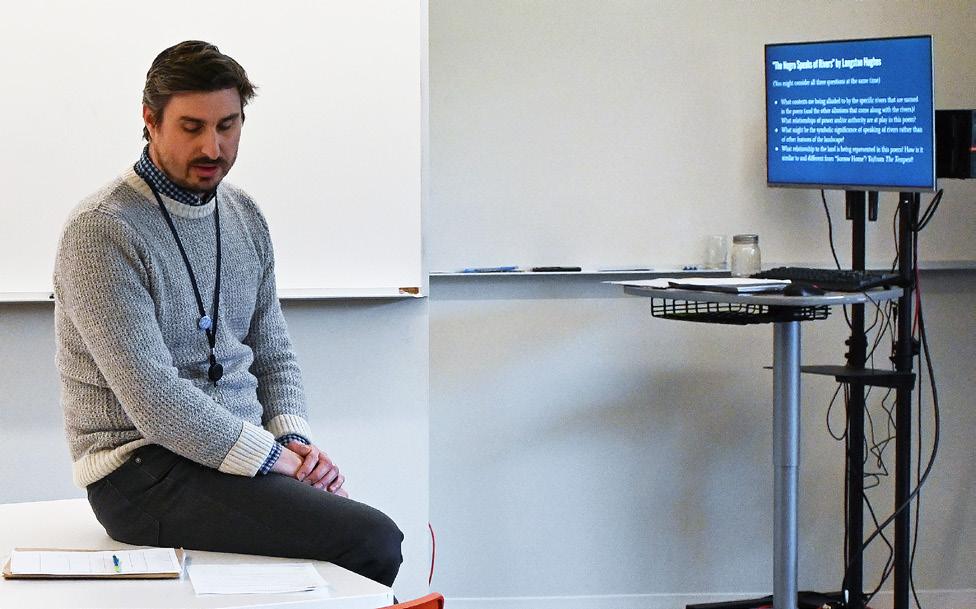

so my partner and I have been considering moving for some time,” he said.
Moving will allow him to see family more often.
“[I look forward to] my children getting to spend time with their grandparents, uncle and aunt, and cousins,” he said.
Klavon said he will miss the connections he has developed with his students and the faculty.
“It has been such a pleasure to work with students … and see their growth,” he said. “My colleagues here are wonderful.”
Klavon hopes the community will continue to expand the bounds of their knowledge and value learning.
As an English teacher,
Klavon specifically hopes his students will continue to enjoy books.
“Keep reading. It feeds your imagination, your critical thinking, your knowledge, your empathy, and your creativity,” he said.
An event celebrating retirees took place May 22 in Redleaf Commons. All faculty and staff will be recognized at closing meetings by department.
Read an OPINION at RubicOnline about the importance of (and ideas for) appreciating teachers.
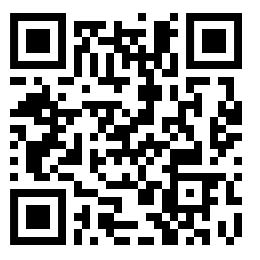
ANNIE
ZHANG EDITOR IN CHIEFAfter a chaotic seniors’ last day of uneven park ing and a Schilling take over, students across all grade levels crowded in the Red Leaf Commons Apr. 26 to celebrate the class of 2024 starting a new chapter of their lives in their senior projects. As the seniors left their mark, the remaining freshmen, sophomores, and juniors were left to fill the responsibilities of the grade above them.
LOOKING FORWARD TO THE TASK OF STRUCTURING MY OWN TIME...
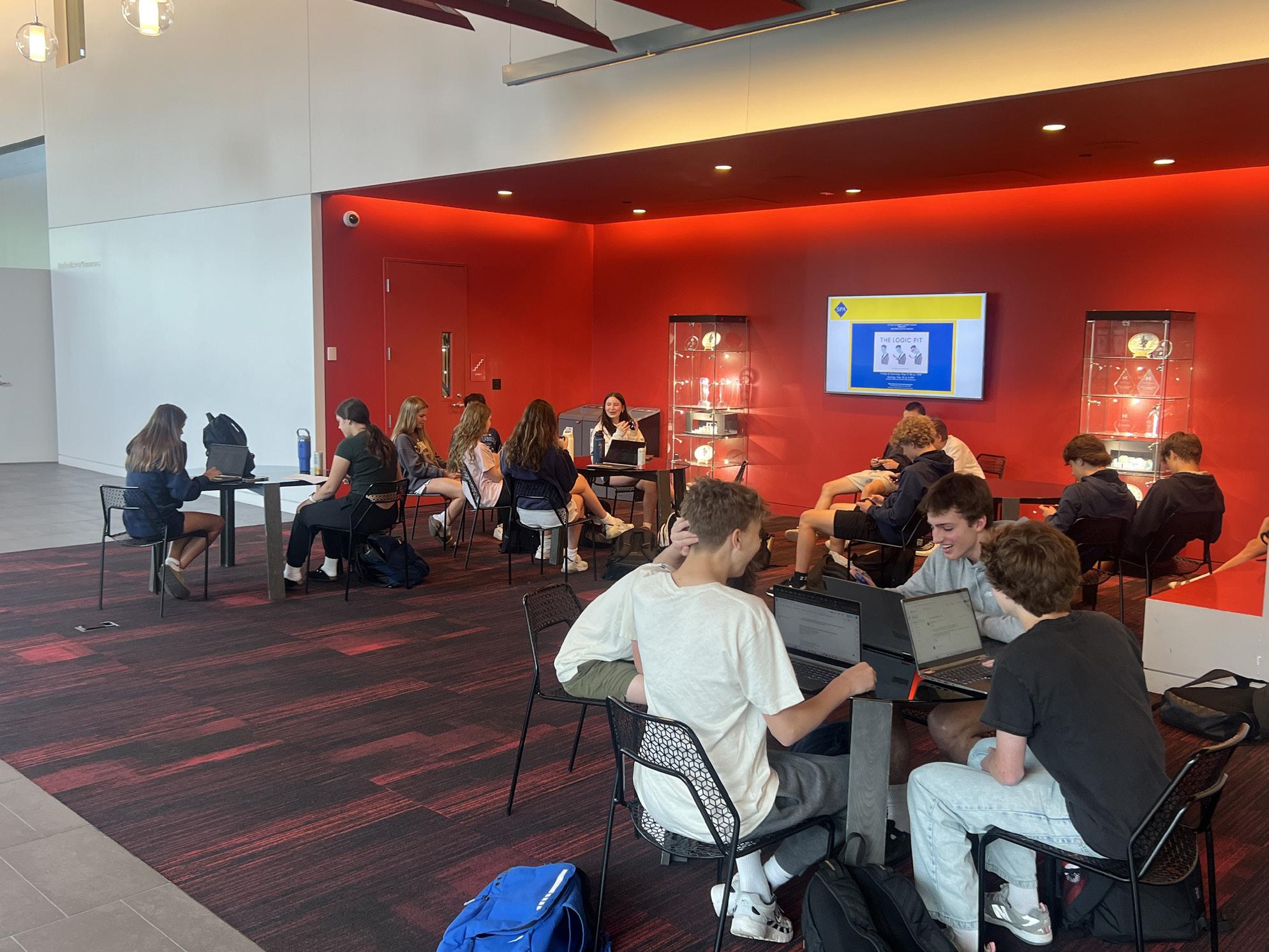

For freshman Sunde Auberjonois, the most significant rite of passage was gaining the freedom to go wherever she desired without a parent chaperone: “Outside of school, one of the most important indicators of my growth as a teenager
responsibility and self management. “Throughout my ninth grade year, I feel like I’ve been guided carefully by adults at SPA to develop a system to keep my work manageable, and are given a lot of structured time in the day for this purpose,” Auberjonois said. “However, as I’m transitioning into sophomore year, I’m looking forward to the task of structuring my own time based on the help I’ve received this year.”
Powerful cards that every “Magic: The Gathering,” player wields in their decks



NIV-MIZZET
This card allows the player to draw cards whenever others cast spells or deal damage against the user.
ANCIENT TOMB
This card allows the player to deal double damage but can be risky due to damage the user takes over time.


For upperclassmen like junior Humza Jameel, who has been in the US community since ninth grade, rites of passage to become leaders look much different. Besides the annual move from Upper Schilling to Lower Schilling, many clubs and affinity groups lack leaders after the seniors’ departure; it is up
to the rising seniors to fill in the gaps. “One way I want to step up next year is in welcoming freshmen in extracurriculars I am a part of,” Jameel said. “It’s crazy how fast time has flown by because I remember being welcomed by seniors in my freshman year [and] I think it’s important to continue the tradition.”
On the other hand, the transition from under to upperclassmen has left sophomore Ella England feeling nervous. Despite the many conversations she’s had with older students telling her that her junior year will be the most stressful, she still holds excitement for this new chapter of her life: “I’ve heard a lot of peo -
ple say that 11th grade is the hardest grade because you’re taking hard electives and you have AP tests and SATs,” she said. From moving into new grade spaces to gaining more freedom, each grade has thewir own unique rites of passage or “unofficial graduation requirements” that students experience.
CARYS
THE RUBICON
For many, playing games serves as downtime from schoolwork and extracurricular activities, outlets for creative expression and friendly competition, and platforms to meet new people. While juniors Theo Su and Ben Lorenz-Meyer are invested in two very different games, all of these reasons for playing games ring true for them.
Ever since he was introduced to the game in elementary school by his friends, Su has been playing “Magic: The Gathering,” the world’s first trading card game that was released in 1993 by Hasbro. “It is a deck-building game and a resource management game,” Su said. “You have to get your opponent’s life points down to zero or make them run out of cards in their library, which is a little bit harder, because they usually have 60 cards.”
In a game, each playre generally has seven cards. Players take the form of Planeswalkers, who are almighty wizards in the game. Their life points are commonly zeroed through combat and creature damage with the use of cards, especially Instant and Sorcery cards, which allow players to cast long-lasting spells, and Creature, Artifact, and Enchantment cards, which spawn creatures and equip artifacts. Although the game is marketed as being free-to-play, the more packs a player buys, the better chance they have of using stronger cards. “There are a lot of different ways to play it. I think that’s one of the appeals of the game,” Su said.
neverending flow of new cards and updates, Su’s passion for the game has always continued. “More cards means more ways to build decks, and I just like the puzzle aspect of trying to figure out how to best use all of the resources that you have access to,” he said.
junior Theo Su “ ENDLESS POSSIBILITIES. Since initial “Magic: The Gathering,” release date in 1993, there have been a total of 27,000
INFOGRAPHIC: Annie Zhang INFORMATION: Theo Su
As his workload gradually piled up over the years, Su has had less opportunities to play the game; nevertheless, he tries to play a round every once in a while with a friend or alone online. However, thanks to the
THERE’S A LOT OF DIFFERENT WAYS TO PLAY [“MAGIC: THE GATHERING”]. I THINK THAT’S ONE OF THE APPEALS...

On the other hand, Lorenz-Meyer discovered his passion for “Minecraft” speedruns 15 months ago and has played every day since then, spending several hours a week on the game. Unlike the original version of “Minecraft,” players try to kill the Ender Dragon, which is the final boss of a “Minecraft world,” as fast as possible while speedrunning. “There’s always a very specific route that you take, but every seed (codes that produce a “Minecraft” world) is different, so [speedruns can be] different every time,” Lorenz-Meyer said. He has especially taken an interest in the game’s world records; the world record stands at seven minutes and one second, and Lorenz-Meyer reached his record of 11 and a half minutes after his first five months of playing. “I’m trying to beat [my record] almost every day,” he said.
Cards. Planeswalkers. Ender Dragon. Creepers. Su and Lorenz-Meyer continue to hold on to these bits and pieces of their respective games, finding joy in them in different ways despite the amount of gameplay that they engage in.

ILLUSTRATION: Ivy Evans
PHRENOLOGY PSYCHOLOGY. Teenage athletes deal with more than the psychical aspects of sports. The psychological benefits are also prominent.
LEUTHOLD THE RUBICON
Participate. Exercise. Compete. People may say, over and over, that it is important to exercise and play sports for improved health and wellbeing. But data backs it up: a study published in the Journal of Adolescent Health found that students who participated in sports in grades 8-12 reported less stress and better mental health as teenagers as well as three years after high school graduation than those who didn’t play sports.
Freshman Stella Hunter, a member of the varsity girls lacrosse team, feels that sports increase moods and provide a break from school.
“During lacrosse, I’m a lot happier. ... When I’m at lacrosse, I kind of forget about all [my schoolwork], which is nice. It’s just a happy place for me. And I can just focus on not school related stuff,” she said.
US Athletic Trainer Anne Hutchins believes it is important to find a balance between aspiring to succeed at a high level and just wanting to have fun in sports.
“There [are] times when you’re participating in [sports] that you might see that there’s a difference in skill level,” Hutchins said. “Knowing that...you’re going to continue to work hard [is important].”
Participating in sports is linked to higher self-esteem and better grades. According to a
study published by the University of Chicago Press, students who participated in sports reported self-esteem scores that were 4.8% higher and 6.1% higher academic achievement scores than those who didn’t play sports.
“
DURING LACROSSE, I’M A LOT HAPPIER. I KIND OF FORGET ABOUT ALL [MY SCHOOLWORK].
freshman Stella Hunter

Oliver Thompson, a captain of the Track and Field team, feels that sports increase focus.
“Physical activity is really helpful, especially after a lot of sitting,” he said. “I’m always more focused after a track practice. The feeling after [track meets] is always great when you challenge and push yourself,” he said.
Hunter uses lacrosse as a way to mentally get through a school day. “[Lacrosse] gives me something to look forward to later if we [...] have practice or something, it gives me motivation. Like, oh, all I have to do is get through these last two classes and then we get to scrimmage or something,” she said.
Even with all the benefits of sports, Hutchins thinks it’s important not to let them take over your life.
“The idea is to make it only a part of your life: you have your academics, ... you have your family, you have your friends,” she said. “Realize [sports are] only one thing. It’s the same as with arts or anything.”
Sit up straight. Present your horse. Walk. Trot. Canter. Whether family traditions have inspired passion and love for a sport or inspiration to take up something new, the SPA community has branched out in sports the student body participates in.
Sophomore Rowan Moore competes as an equestrian, or horseback rider. Specifically, Moore does saddle seat riding, which involves riders and their horse revolving around in a ring and showing off their gaits, which are different sequences of foot movement such as a walk, trot, pace, or canter to judges. Where a competitor will place depends on three criteria: how well they display their horse, the response and balance of a rider’s horse, and the quality of their routine.
“
I’VE LEARNED TO STICK WITH STUFF EVEN WHEN I FEEL LIKE QUITTING OR GIVING UP.
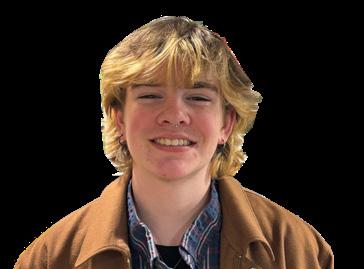
Moore began practicing saddle seat riding at two years old and did their first lead-line class at three years old. Lead line classes are when a rider on a horse is led by an instructor with a leash around the ring. Since they began a young age, they have continued to horseback ride: “I’ve learned to stick with stuff even when I feel like quitting or giving up … Sometimes, I never wanted to go to practice, but I was made to go anyway and enjoyed it almost every time,” Moore said. Horseback riding has been passed down three generations through Moore’s family, “I started through my mom, who got started through her mom, so riding has become a generational thing,” they said. Moore has always had a fondness for horses because
of their novelty in their childhood. “I loved being with and interacting with horses since they’re such interesting animals to me,” they said. “Learning to ride and getting to know the people and animals [gave me] no reason not to stick with it.”
Moore practices weekly on Saturdays during the school year, usually from 10-1:30 p.m. A typical practice will involve a built-in time to socialize with other riders, a 20-minute lesson, taking the tack (saddles, pads and other equipment) off the horses and putting it back, and, on occasion, taking another lesson followed by watching other riders.
One of Moore’s most significant milestones was their switch from Academy to Suit. Academy and Suit are different divisions; Academy is primarily consisting of kids with lesson horses who are new to riding or are less experienced. Meanwhile, Suit mainly consists of adults with more well trained horses to present. “I enjoyed that this [division change] is more com petitive but has a larger range of experience,” Moore said. “When I switched over was also when I got my first horse, which my mom bought.”
Moore aspires to go to the World Championship in Louisville, Kentucky before they finish high school. They have gone through highs and lows in their sport; however the most important idea they developed from competing is: “The best thing I could do for my self was get back on [the horse] and not let my fear win over my desire to keep going.” Moore said.
SUBMITTED PHOTO: Rowan Moore
COUNTLESS DIVISIONS. In the world of horseback riding, there are a total of 17 different divisions for equestrians to compete in, ranging from racing events such as jumping to performance such as saddle seat riding.



4-13-0
Difficult” is how captain Isak Bildsten descibed the season: “We [struggled] to pick up wins, but the team slowly but surley [improved]. “
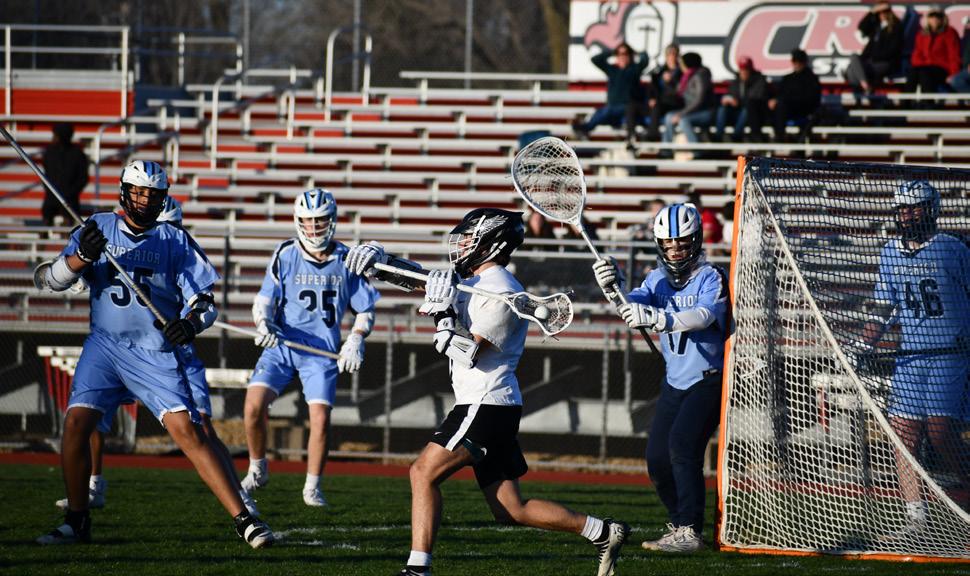
8-3-0
This season the team has won many of our games which should be a positive thing. Still, my teammates and I believe we can improve drastically and become an even better team than we have been,” junior Josh Halloway said. “

9-4-0
The season [went] really well. I believe that the level at which the team has been playing has been very high and I’m proud of how well everyone [has been] competing” freshman Zahir Hassan said. “
Soren Johnson COURSE DRIVER. Sophomore Kai Wetternac winds up to hit a ball while practicing.

2-3-0
4-1-0
We have a great lineup this year and think we can do great things together and individually in the postseason,” captain Henri Peltier said.

1-9-0
My favorite moment was at the end of the game we won when it was pouring and everyone was soaked,” sophomore Franny Wagner said.

8 regular season meets
I feel this season [had] been very productive. I have met a lot of new teammates and gotten faster,” sophomore Patrick Wall said.
A highlight for me this season was winning our first match,” captain Peony Steele said, “and the weather was really nice.” “
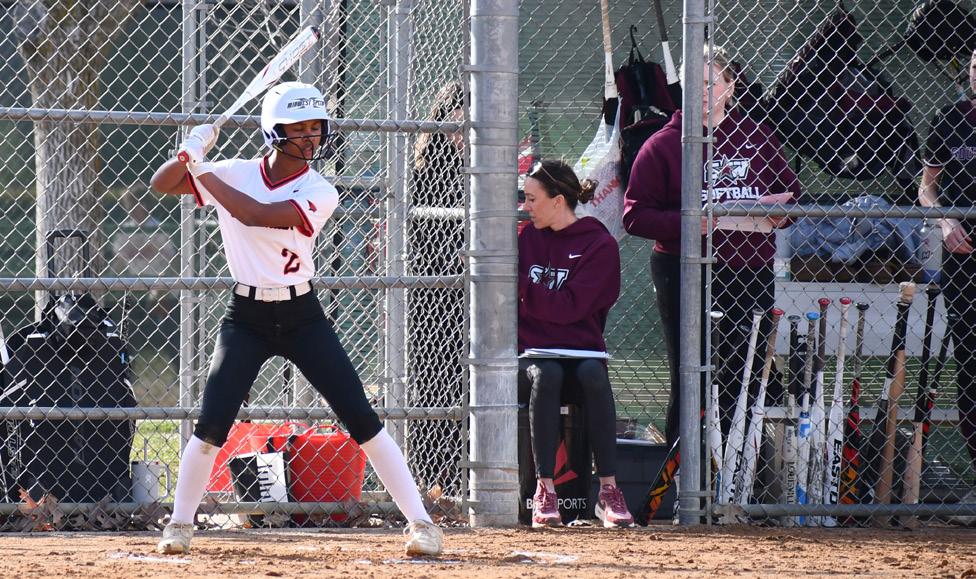
12-6-0
Freshman Juliette Smith thought the season was “super fun getting to know all of the girls from other schools. My favorite game was probably our first win against Southwest Christian.”
 RUBICONLINE PHOTO: Elizabeth Tuttle POWER MOVE. Pitcher Shea Murphy launches the ball from the mound.
IBID PHOTO: Caden Deardurff READY, SET, SERVE. Junior Jacob Colton throws the ball high to smash a serve.
RUBICONLINE PHOTO: Elizabeth Tuttle POWER MOVE. Pitcher Shea Murphy launches the ball from the mound.
IBID PHOTO: Caden Deardurff READY, SET, SERVE. Junior Jacob Colton throws the ball high to smash a serve.
THE RUBICON - MAY 2024

In a streaming-dominated era, going to movie theaters has become a rare occasion for many people because of the convenience of being able to watch anything from home. However, if someone does decide to leave the comfort of their home to watch a movie, they are forced to choose between going to a local theater down the street or a larger theater run by AMC, Cinemark, Emagine, Cineplex, etc. Local movie theaters are often passed over as an option, with the belief there is a better experience at larger corporate movie theaters. Despite the misconceptions, supporting local theaters can help preserve the uniqueness of cinema by centering the movie-going experience on local community interconnectedness.
Junior Victor Valdez works at the Oakdale Marcus Theater, owned by the Marcus Corporation. Still, he believes going to local theaters will
improve the overall experience. “I feel like there are a lot more employees and more people at the bigger theaters, and ... you lose that sense of community that you have in the smaller ones,” Valdez said.
SAINT PAUL
Highland Theater 760 Cleveland Ave S
Grandview Theater 1830 Grand Ave
MINNEAPOLIS
Riverview Theater 3800 42nd Ave S
The Main Cinema 115 SE Main St
Prices are another point of contention. Large movie theaters often charge more than local theaters for better viewing technology or services. Sophomore Howard Huelster is a regular visitor to both local and larger theaters. “A lot of times it’s cheaper to go [to a local theater] … [and it’s] just a lot easier and more convenient,” he said.
However, to compete with corporations, small theaters sometimes have to raise prices depending on their situation, customers, and location. “I think [bigger theaters] can be cheaper sometimes,” Valdez said.
Fluctuations in pricing make it hard to compare the worth or value of going to either theater; however, aiding smaller businesses can lessen the burden of corporate competition. “I think, in general, it’s good to support the people who need the money and not bigger companies who already have a bunch of money,” Valdez said.
Individuals who support these local theaters want to give back and show appreciation. “I think it’s more important to support local theaters,” Valdez said.
As a long-time movie theater-frequenter, Huelster also brings up the harsher rules larger theaters often more heavily enforced. In his experience, local theaters tend to be more flexible and lenient regarding regulations. “AMC is a lot stingier … about age ranges,” Huelster said.
While small on the outside, the role local theaters play is anything but. These smaller theaters maintain an essential duty in the neighborhoods they serve and hold sentimental significance to many. Showing love and support for smaller movie theaters helps sustain their business and continue to broaden their impact, giving future generations a chance to experience the joy of seeing a movie down the street.
Written by choir director Tim Kraack and directed by theater director Eric Severson, The Logic Pit is an innovative and dynamic musical that immersed its audience in the high-stakes world of a tech company, Logic Pittman and Bray, an AI engineering group.
The plot centers around the company’s drastic measures that push its employees to their breaking point, with continued employment contingent on passing tests and winning competitions.
The working cast members of LPB were split up into different groups: the engineers, the R& D team, and the automation team. Each team acted similarly and followed the group’s themes quite well.
The Engineers, led by Charlie (Oliver Zhu) were a group of programmers behind the computer’s revolutionary technology. There were outstanding performances in that group, particularly from Zhu and Kai (Bri Rucker). Two of the engineers, Kai and Lucky (Zain Kizilbash), shared a duet about their love for computers, which sparked a romantic connection.
The R&D team or “ideas” team, was led by Mary (Ellie Putaski), who brought energy, enthusiasm, and humor to the group. Lastly, Adam (Coda Wilson) had an amazing solo number coupled with dynamic acting from Seth (Adam Ebert) rounded out The Automation team.
The management team worked above the rest on an elevated platform, talking down at the companies’ workers, making the hierarchical corporate structure vivid. The management team included vibrant performances from Tasha Logic (Maddie Pierce), the head of the company, and Taylor Barkman (Lucille Brooks). Pierce’s Tasha played a funny, bossy, and demanding employer who placed unrealistic expectations on every employee. One particularly outstanding moment happened when Tasha gave a presentation to children (real children came up on the stage for this number) about the company’s founding – through a song “We Built This Machine,” which featured a guitar solo, puppets, and posters with business lingo such as “venture” and “capitalism.”
It’s a musical that allowed music conposition to take center stage: the show featured a heavy-on-the-drums pop-
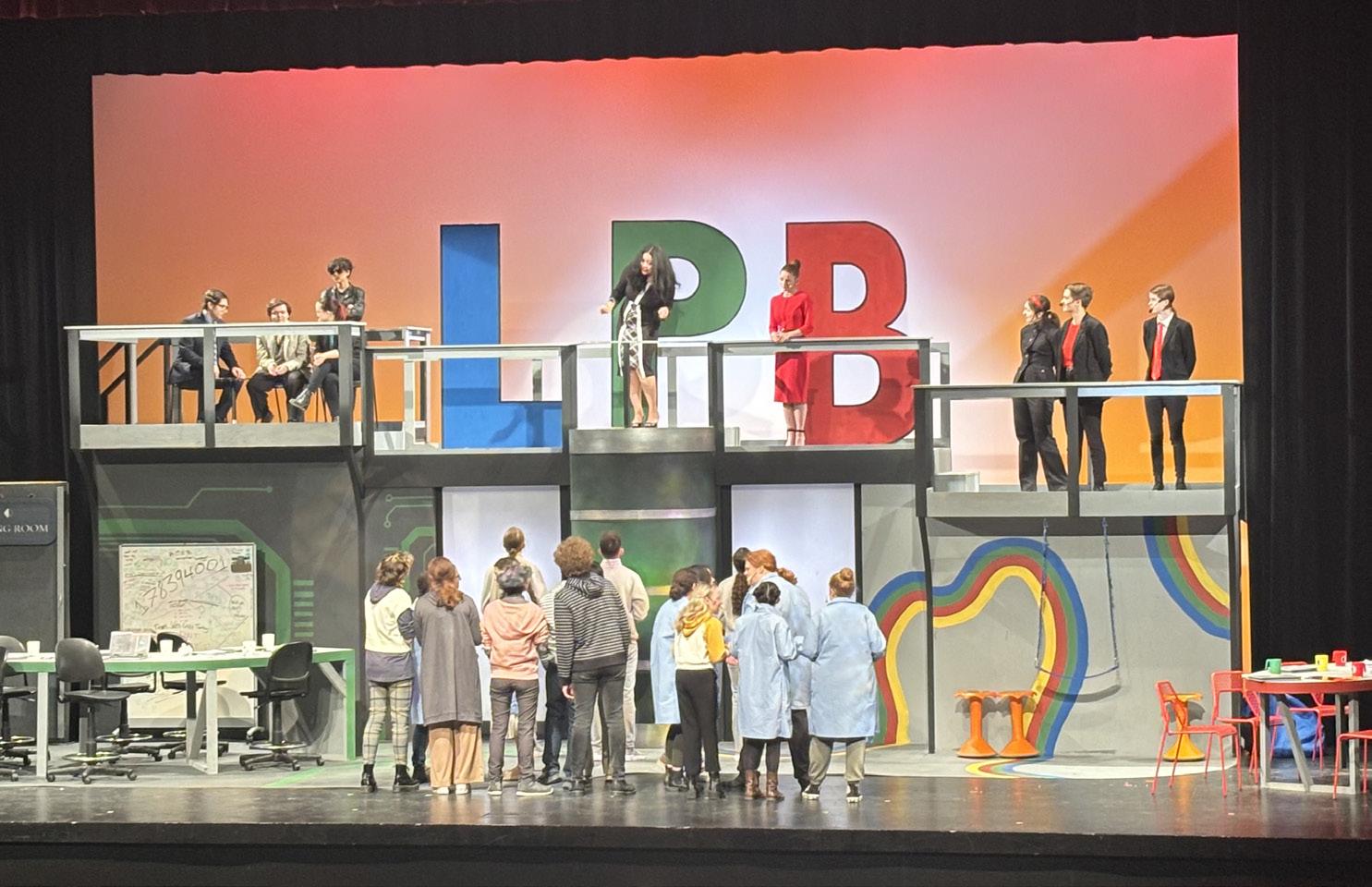
punk electric guitar soundtrack that brought the musical to life. Choruses overlapped with cohesive songs. There were numerous ensemble pieces, but also duets and solos, with each song tying in with the musical narrative seam-
lessly. It was really The Logic Pit’s original score that brought life to a musical about corporate drudgery. To students headed off to summer jobs in corporate America, may you whistle one of Kraack’s tunes while you work.
THE RUBICON - MAY 2024
The Rubicon staff sorts a few recommended titles for the summer
Published in 2018, Educated by Tara Westover continues to be one of the most moving memoirs, exploring familial relationships, religion, and the journey towards knowledge. Westover recounts her experience growing up in a “survivalist” Mormon family and leaving that family to pursue a college education. Westover did not grow up attending school and lived completely off the grid in Idaho. Her story is compelling and tragic, emotional and raw. It is a coming-of-age story, highlighting the gift of knowledge and a young
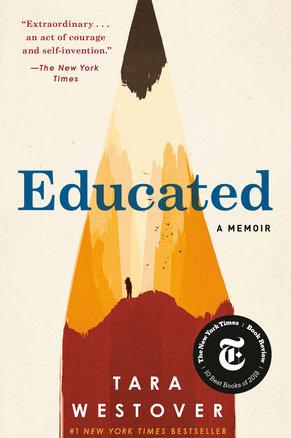
ON THE RUN. Educated is a memoir that recounts author Tara Westover’s experiences growing up in a survivalist Morman household.
girl’s quest to foster a love of learning.
Published in 2022, Groupies is the debut novel from Canadian writer Sarah Priscus. A piece of historical fiction, the story centers around Faun Novak, an innocent college dropout who moves to Los Angeles to live with her best friend Josie. It’s 1977, and Josie is dating Cal Holiday, the lead singer of up-and-coming band Holiday Sun. F. Priscus skillfully weaves a narrative around a time period that is often romanticized, showcasing the exploitative and draining nature of loving a band too much. Groupies is must-read not just for those who enjoy

70’S LOS ANGELES. Groupies depecits a more realistic version of 70’s LA, different then the romanticized vesrsions we often see.
twentieth-century historical fiction, but work that more broadly discusses emotional tragedy.
Circe by Madeline Miller, published in 2018, is a modern adaptation of the tale of the goddess and sorceress Circe from Greek mythology who was best known for turning men into pigs. Bringing a new nuance to the character, Miller weaves old legends with a contemporary perspective, fleshing out the story behind the witch’s many encounters with Greece’s greatest heroes. Despite the plot’s tendency to drag, the book makes up for it by flourishing in its masterfully crafted writing and descriptive details, diving into the intricacies of dealing with

tells a classic story from Greek Mythology in a modern way.
love, death, and, most importantly, what it means to be alive. Lovers of fables and Greek mythology will enjoy this timeless retelling.
We Were Dreamers, published in 2022, by actor Simu Liu, is an autobiography that focuses on his life as an immigrant after leaving Harbin, China, where he spent the majority of his childhood with his grandparents, to live in Canada with his parents. Having spent little time with his parents before his move, Liu hadn’t formed an emotional connection with them yet and his story focuses on attempting to build a bond with these complete strangers. The writing in We Were Dreamers is beautiful and there isn’t much to not enjoy, and because the

Cover: Harper Collins Publishers IMMIGRANT STORY. Focusing on Simu Liu’s childhood, the autobiography details his journey of immigration to Canada.
storyline of the book focuses on Liu’s life, there is not much a reader can “hope” to happen next.
KATHRYN CAMPBELL DIR. OF PUBLICATIONSA retired Chicago PD police officer Cal Hooper moves to rural Ireland and finds everything but the peace and quiet he searches for. Readers will recognize the slowpaced atmospheric narrative inherent in Tana French’s new series in The Hunter. Over 170 pages in, and there isn’t a murder yet; just a setup for a scam. While it’s lovely to be reunited with beloved characters like Lena Olin, the independent neighbor that becomes Hooper’s love interest in “The Searcher” and Trey Reddy, the teen girl whose middle

The Hunter tells the story of a former Chicago PD officer in rural Ireland.
name should be grit, the plot is lacking a compelling mystery, and the details (so far) aren’t doing enough to hook a reader.
GEORGIA ROSS CHIEF VISUAL EDITORAs a part of the Speculative Fiction curriculum, students are currently reading Parable and the Sower by Octavia E. Butler. The novel features a young girl Lauren, the daughter of a Pastor, exploring the growing role of religion in a dystopian doomed environment. The town she lives in is overwhelmed by poverty, starvation, and overall a hopeless future. The book was published in 1993 but is set in 2024, giving this year’s reader an eerie resonance with the book. The balance of dialogue, plot, and poetry, and would recommend this book to a

POETRY-FILLED PAPERBACK. Parable of the Sower features a engagng mix of poetry and plot.
reader who is both curious about religion and thoughtful about current-day issues.
Sabaa Tahir’s March 2022 novel All My Rage follows the lives of two high school students and best friends, Salahudin and Noor, in Juniper, California. As Sal and Noor explore their friendship and identities as Pakistani-Americans, they face growing tension with their families and a desire to escape their small town. All My Rage is recommended for fans of The Poet X, Only This Beautiful Moment, Firekeeper’s Daughter, and We Deserve Monuments.

HIGH SCHOOL BESTIES. All My Rage features a pair of high school best friends exploring their identity as Pakistani-Americans
The 48 Laws of Power (1998) is a self-help book by Robert Green. The book distills laws that someone can follow to become influential. Humanity has the inevitable power-hungry mindset, and The 48 Laws of Power can destigmatize these values and teach how to ethically and considerately learn to hold power and lead. The book allows for a psychological and sociological look at humanity’s pursuit of power.

The Foundation is a science-fiction novel written by legendary author Isaac Asimov. Published in 1951 by Gnome Publishers, the book tells the story of the fall of a galactic empire inspired by the fall of the Roman Empire. The novel features large-scale battles, fascinating technologies, and reflective and thoughtful philosophy and theory, . It is regarded as one of the best science fiction novels of all time.


After the seniors art in the
in April, the


the


art, she invokes nostalgia from familiar logos while paying tribute to her Hmong heritage.
Working with oil pastels, junior June Dalton’s goal with her self portraits was to explore a new medium while creating a deeper understanding of her self-perception.
by her mother who worked as a scientist studying butterflies, junior Ada LaTarte created artwork around insects.
unique personalities for each individual piece.
the several Advanced Art courses offered, such as 2D and 3D workshop and photo and video workshop.
Backroads is a theme built on nostalgia and reflection, an idea that the artists decided on to convey recurring topics in their work. Photography, painting, drawing, ceramic, and fiber art projects are all displayed. For the show, juniors were required to submit at least three pieces and accompanying artist’s statements after pursuing art for at least a semester through one of
Though teachers give students continuing instruction on techniques and are available to talk through ideas, a hallmark of the course is its independence.
Students work largely independently, pursuing what interests and inspires them with little requirement beyond that.
“Backroads” held an opening reception May 10, from 1:05-1:45 pm on May 17.

PHOTOGRAPHIC TRANSFORMATION. While the process an be time consuming, tedious, and risky, junior Hadley Dobish finds her work to be rewarding when it does come together in the end. 1 3 4 5 2
“Backroads,” the exhibition for juniors in Advanced Art Seminar, and the final show of the 23-24 school year, runs 8 a.m. to 4 p.m. in the Drake Gallery from May 10-30.
ARTIST PODCAST: Scan this QR code to listen to Thomas and Dalton talk about their experience producing “Backroads”

or six in the show […] just my favorite ones,” she said.
Mysterious. That’s the word junior Hadley Dobish uses to describe her work in the junior art show “Backroads.” Her contribution is a series of black-and-white film photos picturing landscapes of the East Coast.
FILM PHOTOS: STEP BY STEP
1. Enter the darkroom and take out the film to place in lightproof bucket.
2 Process the film by agitating with water, developing chemicals, and a photographic fixer.
3. Perform a “stop bath” of your film to stop the development.
4. Bring the film into the light and let dry.
5 Cut the film into strips and arrange into a contact sheet.
6 Choose any picture and place it in the enlarger, which will shine a light through the negative photo and project the positive image onto a light-sensitive piece of paper.
7 Repeat the development steps with that piece of paper to create the final photo.
INFORMATION: Hadley Dobish
Dobish has taken photography since her freshman year and plans to continue next year. “I really prefer film photography than digital photography,” Dobish said, “Even though you can get, kind of like the same picture, it’s all about the process that makes it a lot more special to me, I guess.”
Dobish completed this process for her film roll of 36 photos. “I just enjoy being in the darkroom and working with the chemicals and stuff,” she said. But only a select few of her shots make an appearance in “Backroads.”
“I think I have like five
IT’S
ALL ABOUT THE PROCESS THAT MAKES IT SPECIAL TO ME.
junior Hadley Dobish
For her photos, Dobish worked with Kodak film from 1975, which initially gave her some doubt. “So, it was like, over 30 years expired,” Dobish said, “I was really like, ‘what if this doesn’t work? I’m a little bit scared, but I really wanna try it.’ And I was really lucky that the film turned out.”
Dobish has her mom to thank for the experience of working with such old film. “She’s a realtor. And in one of the hous-
es that she was selling, in the basement, they had this huge kind of stash of old film,” Dobish said. I guess she knew that I like those, and she took like a couple canisters and gave them to me.”
So when she took the film to the East Coast on her college visits during spring break, Dobish didn’t know how any of the pictures she was taking were going to turn out. “Sometimes there’s funky things that happen, like, during the development process,” she said. It was entirely possible that Rhode Island, New York, and Canada would come out of the darkroom with unknown splotches obscuring the photos.
But the risk is part of what Dobish loves about film photography. Trying new techniques may not always work, but the end result will be worth the wait. “When it does turn out, it’s so rewarding,” Dobish said.